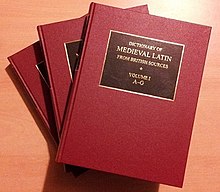
An athame or athamé is a ceremonial blade, generally with a black handle. It is the main ritual implement or magical tool among several used in ceremonial magic traditions, and by other neopagans, witchcraft, as well as satanic traditions. A black-handled knife called an arthame appears in certain versions of the Key of Solomon, a grimoire dating to the Renaissance.

The Chi Rho is one of the earliest forms of the Christogram, formed by superimposing the first two (capital) letters—chi and rho (ΧΡ)—of the Greek word ΧΡΙΣΤΟΣ (Christos) in such a way that the vertical stroke of the rho intersects the center of the chi.

Charles du Fresne, sieur du Cange, also known simply as Charles Dufresne, was a distinguished French philologist and historian of the Middle Ages and Byzantium.

Late Latin is the scholarly name for the form of Literary Latin of late antiquity. English dictionary definitions of Late Latin date this period from the 3rd to the 6th centuries CE, and continuing into the 7th century in the Iberian Peninsula. This somewhat ambiguously defined version of Latin was used between the eras of Classical Latin and Medieval Latin. Scholars do not agree exactly when Classical Latin should end or Medieval Latin should begin.

A Christogram is a monogram or combination of letters that forms an abbreviation for the name of Jesus Christ, traditionally used as a religious symbol within the Christian Church.

A Latin Dictionary is a popular English-language lexicographical work of the Latin language, published by Harper and Brothers of New York in 1879 and printed simultaneously in the United Kingdom by Oxford University Press.

Paul of Venice was a Catholic philosopher, theologian, logician and metaphysician of the Order of Saint Augustine.

Georg Anton Lorenz Diefenbach was a German philologist and lexicographer, as well as a novelist associated with the German Nationalist movement. By career he was a pastor, like his father, and a librarian.

The spatharii or spatharioi were a class of Late Roman imperial bodyguards in the court in Constantinople in the 5th–6th centuries, later becoming a purely honorary dignity in the Byzantine Empire.

Lexicon Mediae et Infimae Latinitatis Polonorum is the most comprehensive dictionary of the Latin language as was used in Poland from the 10th to the middle of the 16th century. Administratively, the dictionary belongs to the Institute of the Polish Language, Kraków, which is incorporated in the Polish Academy of Sciences.
British Latin or British Vulgar Latin was the Vulgar Latin spoken in Great Britain in the Roman and sub-Roman periods. While Britain formed part of the Roman Empire, Latin became the principal language of the elite and in the urban areas of the more romanised south and east of the island. In the less romanised north and west it never substantially replaced the Brittonic language of the indigenous Britons. In recent years, scholars have debated the extent to which British Latin was distinguishable from its continental counterparts, which developed into the Romance languages.
Richard Sharpe,, Hon. was a British historian and academic, who was Professor of Diplomatic at the University of Oxford and a fellow of Wadham College, Oxford. His broad interests were the history of medieval England, Ireland, Scotland and Wales. He had a special concern with first-hand work on the primary sources of medieval history, including the practices of palaeography, diplomatic and the editorial process, as well as the historical and legal contexts of medieval documents. He was the general editor of the Corpus of British Medieval Library Catalogues, and editor of a forthcoming edition of the charters of King Henry I of England.
Robert Jowitt Whitwell B.Litt. was a British medievalist and medieval who made significant contributions to lexicography.

Joan Bastardas i Parera was a Spanish Latinist and Romance philologist, the son of the lawyer and politician Albert Bastardas i Sampere. He studied at the University of Barcelona, with Marià Bassols de Climent, and wrote a PhD dissertation on Medieval Latin syntax, for which he received the Antonio de Nebrija Prize (1951). He was also indirectly a student of the Swedish Latinist Dag Norberg.
Mittellateinisches Wörterbuch is a project for the edition of a comprehensive Medieval Latin dictionary, organised by a committee of the Bavarian Academy of Sciences and Humanities and published with C. H. Beck.
Logeion is an open-access database of Latin and Ancient Greek dictionaries. Developed by Josh Goldenberg and Matt Shanahan in 2011, it is hosted by the University of Chicago. Apart from simultaneous search capabilities across different dictionaries and reference works, Logeion offers access to frequency and collocation data from the Perseus Project.
Ronald Edward Latham (1907–1992) was an English classicist best known for his translation of On the Nature of the Universe by Lucretius. He also translated The Travels of Marco Polo and Bede's 'Ecclesiastical History of the English People.
James Noel Adams was an Australian specialist in Latin and Romance Philology.

Dish-bearers and butlers were thegns who acted as personal attendants of kings in Anglo-Saxon England. Royal feasts played an important role in consolidating community and hierarchy among the elite, and dish-bearers and butlers served the food and drinks at these meals. Thegns were members of the aristocracy, leading landowners who occupied the third lay (non-religious) rank in English society after the king and ealdormen. Dish-bearers and butlers probably also carried out diverse military and administrative duties as required by the king. Some went on to have illustrious careers as ealdormen, but most never rose higher than thegn.

Terence Tunberg is a professor of Latin at the University of Kentucky, specialising in Neo-Latin studies, especially the use of Ciceronian language; and the use of spoken Latin as a teaching tool. He is also Director of the university's Institute for Latin Studies. His academic output is in both Latin and English.












